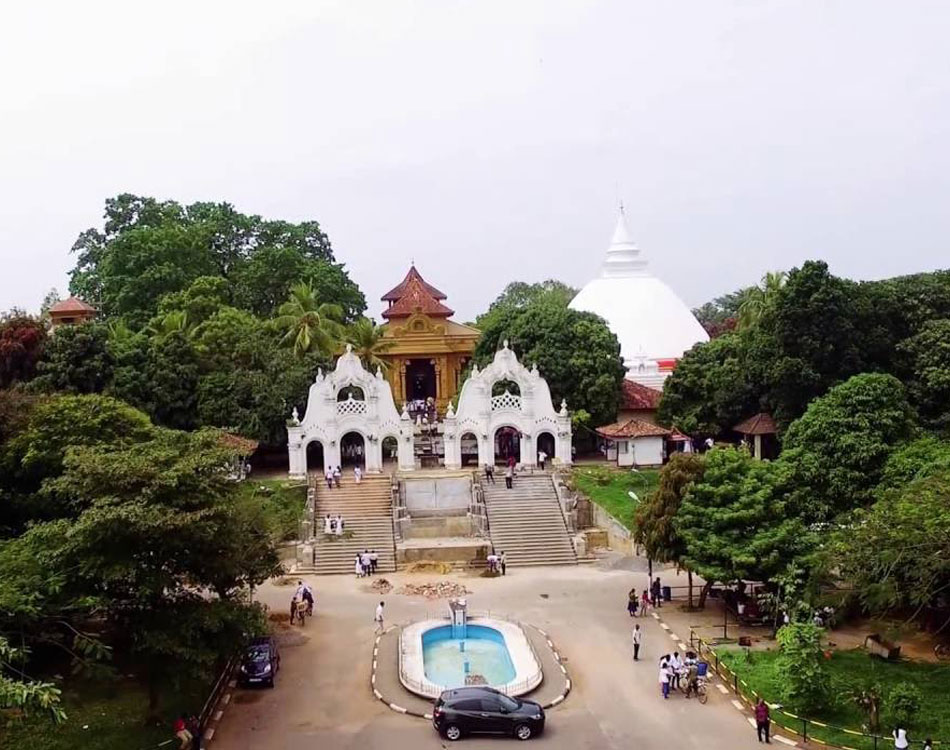KELANIYA TEMPLE
Kelaniya Raja Maha Viharaya, located just seven miles from Colombo, stands as a revered temple attracting Buddhists from near and far. With a rich history dating back to the time of Lord Buddha, this sacred site holds significant importance in Sri Lanka's religious and cultural landscape.
According to historical accounts, Lord Buddha visited this hallowed ground during his Third and final visit to Sri Lanka, marking it as a site of immense spiritual significance. Situated along the banks of the Kelani River, which originates from Sri Pada, the temple's serene surroundings add to its allure, drawing devotees seeking solace and spiritual enlightenment.
The original temple and Stupa, believed to have been constructed in the 5th century BC, have unfortunately not survived to the present day. However, historical records, including the Sri Lankan chronicle "Chulavansa," provide insights into the temple's illustrious past. It is documented that the Kelaniya Temple was once a grand structure, boasting five stories adorned with traditional styling and roofing. Throughout the centuries, the temple underwent multiple renovations and rebuilds under the patronage of various kings, including King Vijayabahu III and King Parakrama Bahu II.
Tragically, in 1510 AD, the temple fell victim to Portuguese conquest and was destroyed, leaving behind remnants of its former glory. Despite these challenges, the temple's significance endured, with subsequent rulers, including King Keerthi Sri Rajasinghe, overseeing its reconstruction in 1769 AD.
Today, Kelaniya Raja Maha Viharaya stands as a testament to Sri Lanka's rich cultural heritage, boasting a plethora of architectural marvels and religious artifacts. Among its notable features is a large gold-plated reclining Buddha image housed within the temple's premises. Additionally, the temple is home to the renowned Dageba or Stupa, known as 'Kalyani Chaithyaya' or 'Kelani Seya,' which holds within it the revered gem-studded chair upon which Lord Buddha is said to have preached.
The temple complex comprises four main sections, each offering a glimpse into Sri Lanka's religious and artistic traditions. Visitors can explore the 'Raja Pilima Ge,' 'Oth Pilima Ge,' 'Aluth Vihara Ge,' and 'Ran Pilima Ge,' each housing unique artifacts and architectural wonders.
Notably, the 'Aluth Vihara Ge' or New Temple House, constructed under the patronage of Helena Wijewardene, stands as a testament to modern architectural and artistic excellence. Housing Kandyan era paintings alongside modern artworks by renowned artist Soliyas Mendis, this section offers a captivating blend of tradition and innovation.
Furthermore, the temple's historical significance is underscored by depictions of past events, such as the tragic incident during the reign of King Kelanitissa, which resulted in a rise in sea levels and the submergence of vast land areas. These historical accounts, depicted in paintings within the temple, serve as poignant reminders of the temple's enduring legacy and its impact on Sri Lanka's cultural narrative.
In conclusion, Kelaniya Raja Maha Viharaya stands as a beacon of spirituality and cultural heritage, offering visitors a glimpse into Sri Lanka's storied past and vibrant religious traditions. With its architectural splendor, religious artifacts, and rich historical significance, this sacred temple continues to inspire awe and reverence among devotees and visitors alike.
Day Tours
See more
See less
Round Tours
See more
See less
Things To Do
See more
See less

